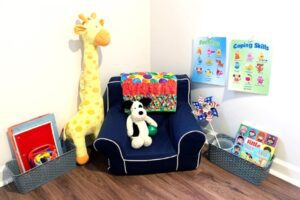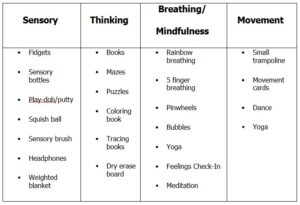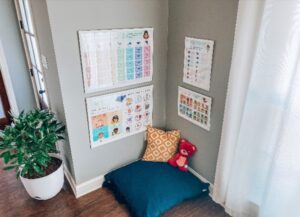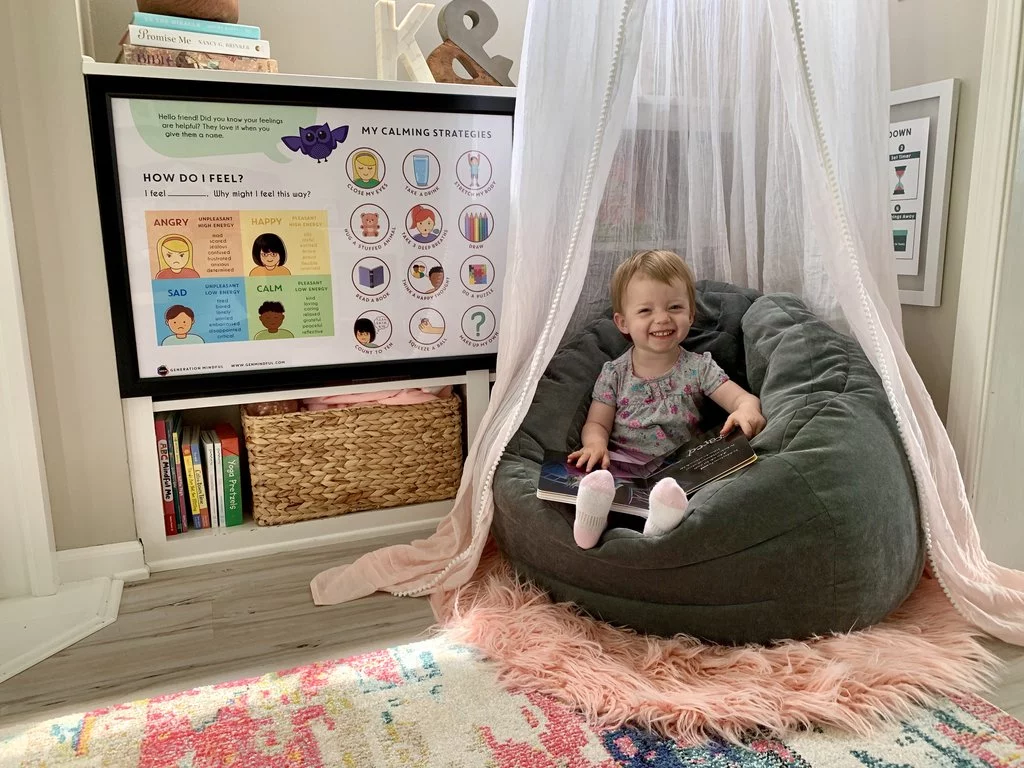How to Create a Calming Corner at Home
A calming corner can be a great tool to help support children’s self regulation needs. These spaces are designed for children to isolate, calm, and re-organize in a meaningful way. This area can be used to take a sensory break and calm down when they are feeling upset, overwhelmed or overstimulated.
A calming corner can include a variety of activities and tools.
What do I need?
- A designated area: Area within the home that is designated for calming corner, should be large enough for one child only and separated from busy/play areas.
- Soft surfaces – bean bag chair, yoga mat, or soft rug
- Headphones – with or without music
- Visual Menu of sensory strategies/activities, see below for ideas
- Timer – visual timers with countdown options are great
- Sensory items such as tactile toys, chewing items, plushies, fidgets, etc.
- Stuffed Animals or Baby Dolls: a baby doll, stuffed animal, blankets, bottles and other caretaking tools, make the space feel cozy and allow children to comfort themself.
- Personal space: Adding a privacy cover or even a simple boundary to the cozy corner space helps children not to be distracted by other aspects of the environment. Creating a makeshift “fort”, or using a small tent/canopy can be a nice option for this.
- Feelings check-in could be a great addition to this space. The child could enter the calm down area and identify how they are feeling and then use strategies to support those needs.
Some children may also benefit from more active choices to help calm their bodies down. Here are some ways to incorporate movement into calming corners that also have a calming effect on the body.

How to Add Movement to a Calm Down Corner:
There are two different types of movement patterns that support the sensory systems, proprioceptive and vestibular movement. Both of these types of movement calm the central nervous system through informing the body of where it is in space through providing input to muscles and joints. However, movement is complicated as it can be alerting and calming. What may be alerting for one child, can be calming for another. Trial and error may be required to determine what is effective for your child when introducing movement based calming activities.
Proprioceptive Calm Down Corner Ideas!
- Jumping mat or small trampoline.
- Weighted blankets
- Weighted ball, can be used to roll back and forth or lift up and down
- Play Dough or therapy putty
Vestibular Calm Corner Ideas
- Swinging –linear, back and forth rocking is typically calming. A rocking chair or blanket swing can be good options for this as well.
- Trampoline
- Dancing – Any type of movement to music, including freeze dancing or shaking instruments (such as a tambourine, bells, maracas) or using scarves
- Yoga Poses – Adding a themed yoga book/cards to the calm down area can be fun options for this
Using the calming corner will take practice and coaching at first. Children need to be taught when a break may be needed, but over time children will start to read and understand their body cues and realize when they may need a break. Over time, they will begin to independently seek out these breaks when needed.
This area should be accessible for your child at any time of the day. It should be set up in a central location in the home that the child feels comfortable in. This area is best used when it is at the child’s level, is situated in an area of the home outside of their bedroom and is away from the busier/louder areas of the home (i.e. kitchen, TV, laundry room etc.) and includes sensory supports to encourage calming and peaceful experiences.
The key is to create an environment that is quiet, comfortable, and free from distractions, allowing your child to recharge and regain focus and practice calming techniques that will help them manage their emotions.
How many Activities should I include?
Sometimes less is more! You should include one activity per category to provide your child a variety of options but that is not too many that it becomes overwhelming. Activities and options can also be rotated to maintain a sense of novelty and excitement to the calming corner.

Important Things to Remember:
This space should never be used as punishment or “time out”, rather should be used as a place where a child can go where they are able to go when they are feeling overwhelmed, overstimulated, frustrated, or upset and need some time and space to get grounded and reset.
This space is NOT to be used for play. Please restrict this area during free play. Please also try to keep items used in the calming corner separate from other toys and refrain from bringing additional items into the calming corner unless they are used as tools.
With permission from your child, you should accompany them into the calming corner in order to help them select appropriate strategies and use their regulation tools appropriately. If your child is upset, modeling from a far can also be a good strategy.

How Long Should a Child use a Calming Corner?
Five minutes should be enough time to allow your child to use this space to calm down, but use your best judgment. If they need more or less time, that is okay. Using visual timers can also be helpful to support transitioning out of the calming corner.
If you feel your child needs help navigating big feelings and that you could also benefit from how to coach your child to cope with these, please call today to schedule an assessment from our pediatric professionals. We can be reached at 773-687-9241 to help with all feelings, big and small!


